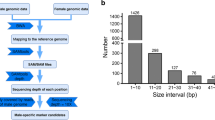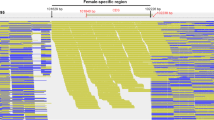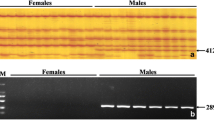Abstract
Spotted knifejaw (Oplegnathus punctatus) is a marine teleost species that is economically important for aquaculture and marine pasture proliferation and shows obvious bisexual growth dimorphism, but molecular sex markers are currently lacking. A 290 bp (base pair) insertion with two fragments (230 bp and 60 bp) was identified in male individuals of O. punctatus based on whole-genome sequencing scanning and structural variation analyses. The gene annotation results showed that the insertion event occurred in the Igfn1 gene of male O. punctatus. The results of amino acid analysis further showed that the insertion event resulted in the functional variation of Igfn1 in male O. punctatus, and recombination caused the inactivation of Igfn1. According to the male-specific insertion information, we designed a PCR-based genetic amplification technique for rapid sex identification in O. punctatus. The results of agarose gel electrophoresis showed that two DNA fragments of 635 bp and 925 bp were amplified in male O. punctatus, while only a single DNA fragment of 635 bp was amplified in female individuals. The sex of individuals identified by this method was consistent with their known phenotypic sex, which will improve sex identification efficiency. This method provides a new DNA marker for rapid sex identification in O. punctatus, which has great significance and application value in monosex breeding and provides new insights for the study of Igfn1 gene recombination and inactivation in male O. punctatus.





Similar content being viewed by others
References
Baker J, Riley G, Romero MR, Haynes AR, Hilton H, Simon M, Hancock J, Tateossian H, Ripoll VM, Blanco G (2010) Identification of a Z-band associated protein complex involving KY, FLNC and IGFN1. Exp Cell Res 316:1856–1870
Bosutti A, Scaggiante B, Grassi G, Guarnieri G, Biolo G (2007) Overexpression of the elongation factor 1A1 relates to muscle proteolysis and proapoptotic p66((ShcA)) gene transcription in hypercatabolic trauma patients. Metab-Clin Exp 56:1629–1634
Charlesworth B (1996) The evolution of chromosomal sex determination and dosage compensation. Curr Biol 6:149–162
Charlesworth B, Charlesworth D (2000) The degeneration of Y chromosomes. Philos Trans R Soc Lond B Biol Sci 355:1563–1572
Chen CJ, Chen H, Zhang Y, Thomas HR, Frank MH, He YH, Xia R (2020) TBtools: an integrative toolkit developed for interactive analyses of big biological data. Mol Plant 13:1194–1202
Chen JL, Walton KL, Winbanks CE, Murphy KT, Thomson RE, Makanji Y, Qian HW, Lynch GS, Harrison CA, Gregorevic P (2014) Elevated expression of activins promotes muscle wasting and cachexia. Faseb J 28:1711–1723
Cox RM, Stenquist DS, Calsbeek R (2009) Testosterone, growth and the evolution of sexual size dimorphism. J Evol Biol 22:1586–1598
Darling AC, Mau B, Blattner FR, Perna NT (2004) Mauve: multiple alignment of conserved genomic sequence with rearrangements. Genome Res 14:1394–1403
Gong J, Li BJ, Zhao J, Zhou ZX, Ke QZ, Zhu QH, Xu DD, Zhou T, Xu P (2022) Sex-specific genomic region identification and molecular sex marker development of rock bream (Oplegnathus fasciatus). Mar Biotechnol 24:163–173
Gui J, Zhu Z (2012) Molecular basis and genetic improvement of economically important traits in aquaculture animals. Chin Sci Bull 57:1751–1760
Gui JF, Zhou L (2010) Genetic basis and breeding application of clonal diversity and dual reproduction modes in polyploid Carassius auratus gibelio. Science China-Life Sciences 53:409–415
Hao Y, Xin HR, Zhang C, Gu XH (2019) Immunoglobulin-like and fibronectin type III domain containing 1 involved in the regulation of skeletal muscle stress damage. Acta Agriculturae Boreali-Sinica 34:380-385
Kakizawa Y, Kamishikiryo K, Shirato M, Maehara S, Fujii H, Iesato S (1980) The tooth development of the parrot perch, Oplegnathus fasciatus, (family Oplegnathidae, Teleostei). J Nihon Univ Sch Dent 22:211–226
Kilpinen S, Ojala K, Kallioniemi O (2010) Analysis of kinase gene expression patterns across 5681 human tissue samples reveals functional genomic taxonomy of the kinome. PLoS ONE 5:14
Li M, Xu H, Xu WT, Zhou Q, Xu XW, Zhu Y, Zheng WW, Li WS, Pang ZF, Chen SL (2020) Isolation of a male-specific molecular marker and development of a genetic sex identification technique in spotted knifejaw (Oplegnathus punctatus). Mar Biotechnol 22:467–474
Li M, Zhang R, Fan GY, Xu WT, Zhou Q, Wang L, Li WS, Pang ZF, Yu MJ, Liu Q, Liu X, Schartl M, Chen SL (2021) Reconstruction of the origin of a Neo-Y sex chromosome and its evolution in the spotted knifejaw, Oplegnathus punctatus. Mol Biol Evol 38:2615–2626
Li X, Baker J, Cracknell T, Haynes AR, Blanco G (2017) IGFN1_v1 is required for myoblast fusion and differentiation. PLoS ONE 12:24
Liu HQ, Cui SQ, Hou CC, Xu J, Chen HX (2007) YY Supermale generated gynogenetically from XY female in Pelteobagrus fulvidraco (Richardson). Acta Hydrobiologica Sinica 718-725. https://doi.org/10.3321/j.issn:1000-3207.2007.05.018
Liu SP (1997) A study on the biology of pseudobagrus fulvidraco in Poyang Lake. Chin J Zool 11-17. https://doi.org/10.13859/j.cjz.1997.04.005
Liu W, Xie Y, Ma J, Luo X, Nie P, Zuo Z, Lahrmann U, Zhao Q, Zheng Y, Zhao Y, Xue Y, Ren J (2015) IBS: an illustrator for the presentation and visualization of biological sequences. Bioinformatics 31:3359–3361
Mansilla F, Dominguez CAG, Yeadon JE, Corydon TJ, Burden SJ, Knudsen CR (2008) Translation elongation factor eEF1A binds to a novel myosin binding protein-C-like protein. J Cell Biochem 105:847–858
Paco S, Kalko SG, Jou C, Rodriguez MA, Corbera J, Muntoni F, Feng L, Rivas E, Torner F, Gualandi F, Gomez-Foix AM, Ferrer A, Ortez C, Nascimento A, Colomer J, Jimenez-Mallebrera C (2013) Gene expression profiling identifies molecular pathways associated with collagen VI deficiency and provides novel therapeutic targets. PLoS ONE 8:15
Panasyuk G, Nemazanyy I, Filonenko V, Negrutskii B, El’skaya, A.V. (2008) A2 isoform of mammalian translation factor eEF1A displays increased tyrosine phosphorylation and ability to interact with different signalling molecules. Int J Biochem Cell Biol 40:63–71
Piferrer F, Ribas L, Diaz N (2012) Genomic approaches to study genetic and environmental influences on fish sex determination and differentiation. Mar Biotechnol 14:591–604
Rahimov F, King OD, Warsing LC, Powell RE, Emerson CP, Kunkel LM, Wagner KR (2011) Gene expression profiling of skeletal muscles treated with a soluble activin type IIB receptor. Physiol Genomics 43:398–407
Ros AFH, Becker K, Canario AVM, Oliveira RF (2004) Androgen levels and energy metabolism in Oreochromis mossambicus. J Fish Biol 65:895–905
Ruckstuhl KE, Neuhaus P (2002) Sexual segregation in ungulates: a comparative test of three hypotheses. Biol Rev 77:77–96
Sanges C, Scheuermann C, Zahedi RP, Sickmann A, Lamberti A, Migliaccio N, Baljuls A, Marra M, Zappavigna S, Reinders J, Rapp U, Abbruzzese A, Caraglia M, Arcari P (2012) Raf kinases mediate the phosphorylation of eukaryotic translation elongation factor 1A and regulate its stability in eukaryotic cells (vol 3, e276, 2012). Cell Death Dis 3:1
Shaffer SA, Weimerskirch H, Costa DP (2001) Functional significance of sexual dimorphism in Wandering Albatrosses, Diomedea exulans. Funct Ecol 15:203–210
Szekely T, Weissing FJ, Komdeur J (2014) Adult sex ratio variation: implications for breeding system evolution. J Evol Biol 27:1500–1512
Waterhouse AM, Procter JB, Martin DM, Clamp M, Barton GJ (2009) Jalview version 2—a multiple sequence alignment editor and analysis workbench. Bioinformatics 25:1189–1191
Xiao Y, Xiao Z, Ma D, Zhao C, Liu L, Wu H, Nie W, Xiao S, Liu J, Li J, Herrera-Ulloa A (2020) Chromosome-level genome reveals the origin of Neo-Y chromosome in the male barred knifejaw Oplegnathus fasciatus. iScience 23:101039
Xiao YS, Xiao ZZ, Ma DY, Liu J, Li J (2019) Genome sequence of the barred knifejaw Oplegnathus fasciatus (Temminck & Schlegel, 1844): the first chromosome-level draft genome in the family Oplegnathidae. GigaScience 8:8
Xiao ZZ (2014) Study on population genetics and culture biology of Oplegndthus fasciatus. Ocean University of China.
Xue R, An H, Liu QH, Xiao ZZ, Wang YF, Li J (2016) Karyotype and Ag-NORs in male and female of Oplegnathus Punctatus. Oceanologia et Limnologia Sinica. Oceanologia Et Limnologia Sinica 47:626–632
Zheng X, Kuang Y, Lv W, Cao D, Zhang X, Li C, Lu C, Sun X (2013) A consensus linkage map of common carp (Cyprinus carpio L.) to compare the distribution and variation of QTLs associated with growth traits. Science China-Life Sciences 56:351–359
Zhu YY (2012) Screening of the AFLP marker linked to the sex locus of Oreochromis niloticus and association between polymorphsims of two genes and growth traits. Huazhong Agricultural University.
Acknowledgements
The authors thank the Institute of Oceanology, the Chinese Academy of Sciences for the infrastructural support, Prof. Zhizhong Xiao for the experimental materials, and Prof. Jun Li for his guidance.
Funding
This work was supported by grants from the National Key Research and Development Program (2018YFD0901204), Key Special Project for Introduced Talents Team of Southern Marine Science and Engineering Guangdong Laboratory (Guangzhou) (GML2019ZD0402), Key Deployment Projects of Center for Ocean Mega-Science, Chinese Academy of Sciences (Frontier Cross-category, COMS2020Q05), China Agriculture Research System (CARS-47), Major Agricultural Application Technology Innovation Project of Shandong Province (SD2019YY01), STS project (KFZD-SW-106, ZSSD-019, 2017T3017, and KFJ-STS QYZX-020), Qingdao National Laboratory for Marine Science and Technology (2018SDKJ0502-2 and 2015ASKJ02), and National Natural Science Foundation of China (No. 31672672).
Author information
Authors and Affiliations
Contributions
YSX and JL conceived and designed the project and revised the manuscript. YTM, JL and YSX performed the genomic investigations and wrote the manuscript. ZZX, YDW, and HXZ participated in data analysis, discussion, and figure preparation. All authors read and approved the final manuscript.
Corresponding author
Ethics declarations
Conflict of Interest
The authors declare no competing interests.
Additional information
Publisher's Note
Springer Nature remains neutral with regard to jurisdictional claims in published maps and institutional affiliations.
Supplementary Information
Below is the link to the electronic supplementary material.
Rights and permissions
Springer Nature or its licensor holds exclusive rights to this article under a publishing agreement with the author(s) or other rightsholder(s); author self-archiving of the accepted manuscript version of this article is solely governed by the terms of such publishing agreement and applicable law.
About this article
Cite this article
Ma, Y., Xiao, Y., Xiao, Z. et al. Identification of Male-Specific Molecular Marker and Development of PCR-Based Genetic Sex Identification Technique in Spotted Knifejaw (Oplegnathus punctatus). Mar Biotechnol 24, 969–978 (2022). https://doi.org/10.1007/s10126-022-10160-w
Received:
Accepted:
Published:
Issue Date:
DOI: https://doi.org/10.1007/s10126-022-10160-w




